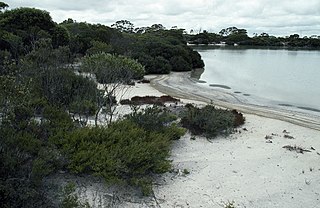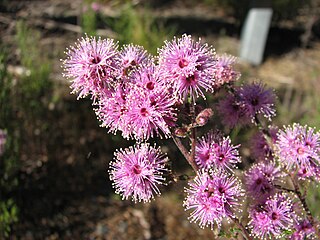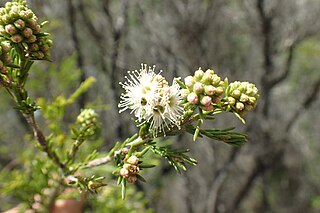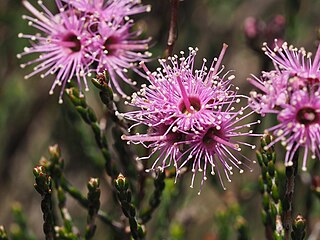
Kunzea salina is a species of flowering plant in the myrtle family, Myrtaceae and is endemic to the south of Western Australia. It is a low, spreading, densely branched shrub with leaves mostly arranged in opposite pairs and usually two sessile pale pink to white flowers arranged at the base of new shoots. It only grows near the edge of certain salt lakes.

Kunzea 'Badja Carpet' is a cultivar of Kunzea badjaensis. It is a low-growing shrub of the family Myrtaceae found in the southeastern tablelands of New South Wales, Australia. It is similar to Kunzea capitata, but it has a lower growth form and white rather than pink flowers. Because of these differences it has been described as a distinct species. The species had previously been known as Kunzea sp. 'Wadbilliga'.

Kunzea parvifolia, commonly known as the violet kunzea, is a flowering plant in the myrtle family, Myrtaceae and is endemic to eastern Australia. It is a wiry shrub with small, narrow leaves and clusters of pink to purple flowers in spring.

Kunzea muelleri, commonly known as yellow kunzea, is a flowering plant in the myrtle family, Myrtaceae and is endemic to mountainous areas of south-eastern Australia. It is a low-growing, spreading shrub with linear leaves and small groups of pale yellow, stalkless flowers that appear in the summer.
Kunzea acuminata is a flowering plant in the myrtle family, Myrtaceae and is endemic to the south-west of Western Australia where it has a restricted distribution. It is a shrub with a few spindly branches, silky leaves and spherical groups of pink flowers on the ends of the branches.

Kunzea clavata, commonly known as the Torbay spearwood, is a flowering plant in the myrtle family, Myrtaceae and is endemic to a small area on the south coast of Western Australia. It is a shrub or tree, typically with many branches and grows to a height of 2.5 to 4 metres. It blooms between September and October producing yellow flowers.

Kunzea spathulata is a species of flowering plant in the myrtle family, Myrtaceae and is endemic to a small area in the south west of Western Australia. It is a tall shrub with erect, much-branched stems, linear leaves and more or less spherical groups of yellow or yellowish green flowers.
Kunzea aristulata is a flowering plant in the myrtle family, Myrtaceae and is endemic to a small area of New South Wales. It is an erect, spreading shrub similar to Kunzea rupestris but is distinguished from it mainly by the shape of its leaves. It is only known from a remote area north of Yerranderie where it often grows on cliff edges.
Kunzea axillaris is a flowering plant in the myrtle family, Myrtaceae and is endemic to a small area of New South Wales. It is an erect shrub or tree with linear leaves and white flowers which are arranged singly in leaf axils. It is only known from the ranges on the north coast.

Kunzea obovata is a flowering plant in the myrtle family, Myrtaceae and is endemic to eastern Australia. It is a spreading shrub with unusually-shaped leaves and clusters of pink to purple flowers. It is restricted to northern New South Wales and south-eastern Queensland.
Kunzea caduca is a plant in the myrtle family, Myrtaceae and is endemic to Queensland. It is a spreading shrub with linear to lance-shaped leaves and groups of white to cream-coloured flowers on the ends of all the branches from late winter to early spring. It is only known from a few locations and only conserved in the Castle Tower National Park near Gladstone.
Kunzea calida is a plant in the myrtle family, Myrtaceae and is endemic to Queensland, Australia. It is a spreading shrub which has linear to lance-shaped leaves but which are rolled, making them appear cylindrical. The flowers are pinkish-purple and arranged in groups near the ends of the branches in September. It is only known in remote and rugged areas of the Mount Stewart Ranges near Homestead.

Kunzea cambagei, commonly known as the Cambage kunzea is a flowering plant in the myrtle family, Myrtaceae and is endemic to a small area of New South Wales. It is a small shrub with egg-shaped leaves and clusters of cream-coloured to yellowish flowers near the end of the branches. It is only known from areas near Mount Werong in the Kanangra-Boyd National Park and Berrima.
Kunzea dactylota is a flowering plant in the myrtle family, Myrtaceae and is endemic to a small area of New South Wales. It is a spreading shrub with small, finger-shaped leaves and clusters of white flowers near the end of the branches. It grows at high altitudes on the Southern Tablelands of the state.
Kunzea graniticola is a plant in the myrtle family, Myrtaceae and is endemic to Queensland. It is a shrub or small tree with linear to egg-shaped leaves and rounded groups of white or cream-coloured flowers on the ends of the branches in August and September. It is only known from forests near Cardwell and on Hinchinbrook Island.
Kunzea juniperoides is a flowering plant in the myrtle family, Myrtaceae and is endemic to a small area of New South Wales. It is a small shrub with narrow leaves and small groups of white flowers near the end of the longer branches. It is distinguished from similar kunzeas by the large number of scale-like perules and bracts surrounding the groups of flowers.

Kunzea occidentalis is a flowering plant in the myrtle family, Myrtaceae and is endemic to a western New South Wales. It is a shrub with narrow leaves and small groups of white flowers on leafy side-branches. It is distinguished from the similar Kunzea ambigua by the flanges on the sides of its young branches.

Kunzea opposita is a plant in the myrtle family, Myrtaceae and is endemic to eastern Australia. It is a spindly shrub which has small leaves arranged in opposite pairs, and pink flowers with five petals and many stamens, the stamens much longer than the petals. It usually grows in woodland or on exposed cliffs.
Kunzea petrophila is a flowering plant in the myrtle family, Myrtaceae and is endemic to the Northern Territory. It is a spreading shrub with hairy branches and leaves, narrow leaves and cream-coloured flowers in more or less spherical groups usually on the ends of the main branches.
Kunzea sericothrix is a plant in the myrtle family, Myrtaceae and is endemic to Queensland. It is a small shrub with linear to lance-shaped leaves. It is only known from a single collection, and the details of its flowers are provisional.










